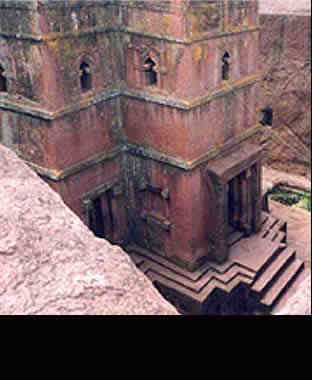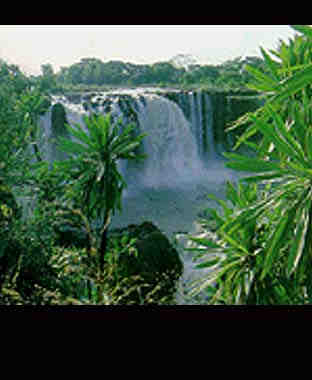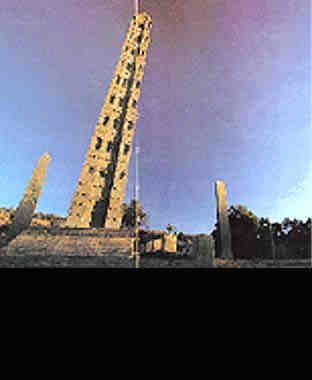
Yeha
©2002: Greenland Travel
|
|
|
Ethiopia passed without any transition phase from a feudal, mediaeval state to "building socialism". Ethiopia was a
meeting point for many peoples from ancient Abyssinia. Yeha, Ethiopia’s most ancient city of the Sabeans (after the
Queen Of Sheba reign there) could date back to as old as the 5th century BC. It laid in the mountains of Tigray region
and legend has it that the Sabeans lived here and has a Temple decorated with pure Gold. Its famous inscriptions,
bronze and crafts have been excavated since the beginning of the 20th century. The last remains of the dynasty are
still a major tourist attraction. Later history is little known until the 17th century Kingdom of Gondar. Ethiopia
managed to avoid colonial conquest; an attempt by Italy was stopped at Adua in 1889.
In 1928 a young feudatory landlord,
Ras Taffari, took power and became the emperor Hailé Selassié. He reigned for 46 years. HAILE SELASSIE led one of the
first independent and democratic countries in Africa. He was also the first President of the Organization of African
Unity. Reggae music is narrowly connected with Haile Selassi and with Ethiopia. Together with Liberia, Ethiopia has
never been colonized. The population is multi-ethnic, with thirty-three percent of the inhabitants Coptic Christians,
while most of the lowlanders are Muslim.
|
|
Ethiopia is made up of two separate parts: the central plateau at about 2000 to 3000 m above sea level, and the low
lying areas which surround it. The lowlands have a hot humid climate in the Sobat basin, hot and dry in Ogaden and
Dancalia. The climate of the highlands depends on the altitude. Ethiopia has the third largest population in Africa,
with only 8,4 % living in towns.
The scenery is spectacular with a unique birth life of over 850-recorded species
and the impressive Blue Nile Falls, 400 meter wide and 50 meter deep are the Blue Nile Falls, locally known as Tis
Isat. Ethiopian Orthodox Christians believe that the original Ark of the Covenant resides in Axum, a place also known
for the Stole Stele. The Stele Field contains huge granite monoliths or steles are symbols of ancient grandeur
(30 meters).
|
|

Blue Nile
©2002: Greenland Travel
|

Axum
©2002: Greenland Travel
|
|
|
Lucy and her Ancestors:
"Lucy Australopithecus Afarensis" is the Star of the National Museum of Addis Ababa. When her 3.5 million-year-old
skull and incomplete skeleton were found in 1974 at a lake near Hadar in the most easterly part of Ethiopia’s Afar
region, it caused a radical rethink of the timescale for humankind’s development. It is in the Afar region of Ethiopia
where scientists discovered the remains of "Lucy" or Dinkenesh, meaning "thou art wonderful," as she is known to the
Ethiopians. "Lucy" lived more than three million years ago.
Addis Ababa:
Addis Abeba is strategically located in the center of the country and was founded by Emperor Menelik II. Its precursor,
Entoto, was unsuitable because of very cold temperatures and scant supply of firewood. The Empress Taitu, wife of
Emperor Menilek II (reigned 1889-1913), talked the emperor into constructing a house near hot springs. The city was
consequently founded in 1887 and was called Addis Ababa ('New Flower') by the empress. The city was the capital of
Italian East Africa during the brief occupation from 1935-1941. Amharic and English are the official languages beside
seventy ethnics dialects. Addis Abeba is full of varied architectures; religion, economic and social exchanges. Washa
Michael which dates back to 4th century A.D, is the oldest site while the complex United Nation's conference centre is
the most recent in Addis Abeba. The Addis Abeba University (1950) and some other training colleges and technical
schools are located here. Other places of interest are the Museum of the Institute of Ethiopian Studies, the National
School of Music, the National Library and Archives, mansions of previous emperors, and governmental bureaus.
International organizations such as the Organization of African Unity and the United Nations Economic Commission
for Africa have their headquarters here. The Mercato, located in west Addis Ababa, is a huge open-air market. The
Piazza, in the central part of Addis Ababa, contains European-style shopping centers. A little zoo is positioned
near the university. One can go boating, waterskiing, bathing, and can bird-watch in the lake region in the south.
Economy:
Agricultural production is increasing, heavyweight corporations are slowly being privatized and tourism, from a zero
base, is already the country’s second biggest foreign-exchange earner after coffee. The NGO "Farm Africa" established
a luxury camp beside Lake Langano. The money it brings goes to local people. They run the camp (42 work as guides,
cooks, and gardeners and so on. Profits in only two years have funded a clinic, a new school, piped drinking water
and a tree nursery to compensate the villagers for giving up their traditional wooding rights.
Ethiopia has a mixed farming economy, raising both crops and animals. The major crops are grains: mostly teff
(a grain native to Ethiopia), wheat, barley, sorghum, millet, and maize. Manufacturing forms only a minor part
of the Ethiopian economy. The country has the lowest exports per capita in the world; coffee accounts for some
two-thirds of merchandise exports. Given the country's agriculture-centered economy, Ethiopia is particularly
vulnerable to the adverse effects of fluctuations in commodity prices (especially coffee), and drought, which is
frequent. Widespread famine resulting from failure of the short rains (belg) has threatened an estimated 10 million
Ethiopians. Ethiopia’s economy continues to grow stronger as it solidifies its transition from a command to a
market-based economy. Its extensive system of price controls has been almost entirely dismantled, tax rates have
been lowered, and some restrictions on the private sector have been removed. However, the conflict with Eritrea
and the drought have put extreme pressure on the economy.
The President:
Lt. Girma Wolde-Giorgis, who was elected as the second president of the Federal Democratic Republic of Ethiopia
(FDRE) on October 8, 2001, was born in Addis Ababa in December 1924. Lt. Girma joined Teferi Mekonnen School in
Addis Ababa in 1936 where he completed his elementary education. He had also followed different training courses
within and outside the country and received various certificates. Among the certificates Lt. Girma got are in aviation
administration from Sweden, in aviation traffic from Canada and from the School of Social Studies in Holland. Lt.
Girma speaks three local and three foreign languages, namely Amharic, Oromiffa, Tigrigna, and Italian, English and French.
The new president is a father of five children, one of whom is widely believed to be the EPRP’s representative in
Europe - Ms Genet Girma. Lt. Girma himself hinted at this with a statement in his interview with Ethiopian television
“Awde Seb” program, by saying, “All of my children are active participants in the Democratic process.”
Enabling us to improve the quality of the content, if you have additonal information, remarks or suggestions,
please share it with us by e-mail.
ADDIS ABABA, 5 October 2001: British Airways started commercial flights between London and Addis Ababa
from October 5, 2001, onwards. BA's franchise partner, British Mediterranean Airways will operate two flights
a week through Alexandria, Egypt. Flights are from London to the Addis Ababa every Monday and Thursday, with
return flights on Tuesdays and Fridays.
ADDIS ABABA: A Hollywood firm plans to take 200 Ethiopian farmers from a remote province to Namibia for
parts in "Beyond Borders", a big budget movie starring Angelina Jolie and Kevin Costner. Ethiopian participants
will stay for six weeks in Namibia. The southern African country was selected for having a more developed road
infrastructure and its proximity to South Africa, which has the necessary support system for the sophisticated and
bulky camera equipment and accessories used by Hollywood. Production is in the hands of Lions Gate International.
Ethiopia's catastrophic famine of the 1980s is one of the settings for the film, in which Costner plays an
international medical relief worker and Jolie a high-society woman drawn into war-torn and drought-stricken areas
in need of humanitarian assistance. Kenya was initially selected as the location for parts of the film, directed
in part by Martin Campbell (whose recent movies include "The Mask of Zorro" and "Vertical Limit"), but was ruled
out for security reasons.
Last update: 22 April 2008
|

|